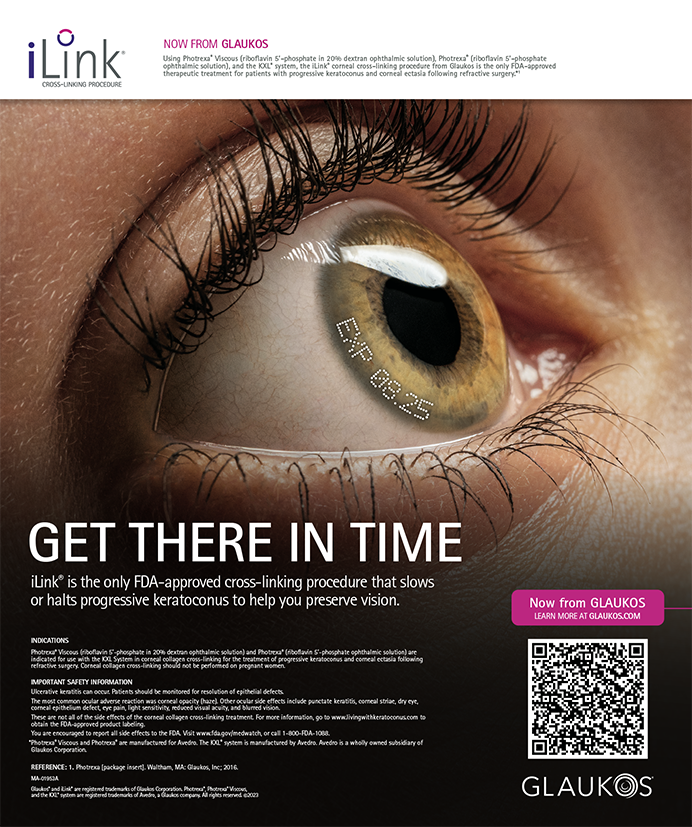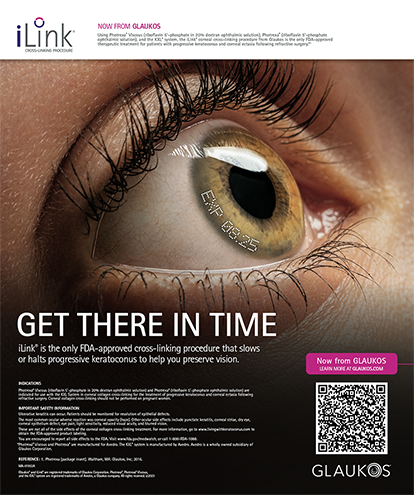The pace of innovation in refractive surgery is among the most rapid of any field of medicine, and such innovation depends on clinical and industrial research’s occurring congruently. Private practices tend to have flexibility and autonomy to make decisions regarding new technology and new services and therefore have contributed to refractive surgery research disproportionately compared to other medical fields. I have strived to contribute to the advancement of refractive surgery through research in my private practice, and my faculty appointment at a local ophthalmology residency program facilitates collaboration with statisticians, residents, and fellows.
In our practice, one of our projects is a long-term ongoing study of ocular residual astigmatism (ORA). First described more than 40 years ago by Duke-Elder,1 this concept is often overlooked in the setting of refractive surgery despite evidence of its clinical importance (Figures 1 and 2). Studies have shown that eyes with high ORA tend to have decreased treatment efficacy compared to eyes with low ORA (Figure 3).2-5 As they strive to maximize refractive surgery outcomes, improve quality of vision for patients, and decrease enhancement rates, ophthalmologists must be cognizant of ORA.
Although ORA is known to be important in refractive surgery, the prevalence of high ORA is not yet well established. Our most recent work on this subject is a demographic study as to the prevalence of high ORA in the general population.
RETROSPECTIVE STUDY
The records of dominant eyes of patients who underwent LASIK or PRK from November 2012 to November 2013 were retrospectively analyzed to determine ORA and treatment efficacy. The ORA was determined by vector analysis using iASSORT software and the Alpins Index of Success Method.6 The ratio of ORA to preoperative refractive cylinder (R) was determined in order to differentiate predominantly anterior corneal astigmatism (ORA/R ratio < 1.0) from eyes with predominantly noncorneal ORA (ORA/R ratio > 1.0). These values were then analyzed by sex and age (18-44 and ≥45 years of age). The P value was determined using t-test statistical analysis. A P value less than .05 was considered statistically significant.
The study evaluated 175 eyes of 175 patients. The average ORA/R ratio of the entire patient population was found to be 1.1. The average ORA/R ratio was found to be 0.98 (n = 95) for men and 1.27 (n = 80) for women (P < .0001) (Figure 1). The average ORA/R ratio of the two age groups was found to be 1.08 for 18 to 44 (n = 129) and 1.16 for 45+ (n = 46) years of age (P < .0001) (Figure 3).
Our data suggest that the average ORA of a single Midwestern refractive surgery population is greater than 1.0. This finding is important and underscores the importance of careful consideration of astigmatic origin prior to refractive surgery.
The increased average ORA in women compared to men is an interesting finding (Figure 4), and although statistically significant, it may not be clinically relevant. More work is needed to determine whether the ORA average difference of 0.975 compared to 1.27 is a significant contributor to surgical results.
CONCLUSION AND FUTURE DIRECTIONS
The significantly higher ORA values in the cohort of patients older than age 45 is perhaps the most significant result of the analysis (Figure 5). This trend is likely due to age-related changes in the crystalline lens as dysfunctional lens syndrome continues to progress. This finding suggests that lens-based surgery should be considered in older patients presenting with high ORA. Proceeding with LASIK or PRK in these high-ORA patients will lead to the inverse of the lenticular astigmatism being permanently imprinted in the anterior corneal surface, despite the astigmatism’s arising from the crystalline lens. Furthermore, as the crystalline lens continues to change with age, it is reasonable to assume there is a higher enhancement rate in this older age group. We are currently looking at our data to see if this hypothesis is true.
Lance Kugler, MD, is a surgeon and CEO of Kugler Vision in Omaha, Nebraska and also serves as the director of refractive surgery at the University of Nebraska Medical Center. Dr. Kugler may be reached at lkugler@lasikomaha.com.
Linda Morgan, OD, specializes in refractive surgery perioperative management and clinical research at Kugler Vision in Omaha, Nebraska. Dr. Morgan may be reached at drmorgan@lasikomaha.com.
Jonathan Crews, MD, is a second year ophthalmology resident at the University of Nebraska Medical Center. Dr. Crews may be reached at jonathan.crews@unmc.edu.
- Duke-Elder S, ed. System of Ophthalmology. Vol. 5: Ophthalmic Optics and Refraction. St Louis, MO: Mosby; 1970:275-278.
- Kugler L, Cohen I, Haddad W, Wang M. Efficacy of laser in situ keratomileusis in correcting anterior and non-anterior corneal astigmatism: comparative study. J Cataract Refract Surg. 2010;36:1745-1752.
- Labiris G, Gatzioufas Z, Giarmoukakis A, et al. Evaluation of the efficacy of the Allegretto Wave and the Wavefrontoptimized ablation profile in non-anterior astigmatisms. Acta Ophthalmologica. 2012;90:442-446.
- Qian Y, Huang J, Chu R, et al. Influence of intraocular astigmatism on the correction of myopic astigmatism by laserassisted subepithelial keratectomy. J Cataract Refract Surg. 2014;40:558-563.
- Quian YS, Huang J, Chu RY, et al. Influence of internal optical astigmatism on the correction of myopic astigmatism by LASIK. J Refract Surg. 2011;27(12):863-868.
- Alpins N. Astigmatism analysis by the Alpins Method. J Cataract Refract Surg. 2001;27:31-49.


